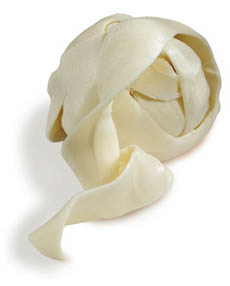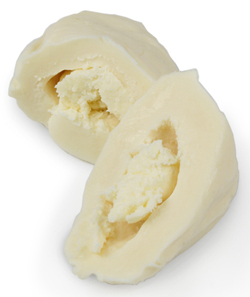
 Queso Oaxaca, a mozzarella-type string cheese. It is named after the Mexican state of Oaxaca, where it was first made. You can purchase it from Mozzarella Company. Queso Oaxaca, a mozzarella-type string cheese. It is named after the Mexican state of Oaxaca, where it was first made. You can purchase it from Mozzarella Company.
|
STEPHANIE ZONIS focuses on good foods and the people who produce them.
|
|
May 2006
Updated September 2009
|
 |
Mozzarella Cheese
Page 3: Types Of Fresh Mozzarella
This is Page 3 of a five-page article. Click on the black links below to visit other pages.
Types of Mozzarella
There are different types of mozzarella, too, other than the variations that will result from using cow’s or buffalo’s milk. The cheese is available salted or unsalted, in low moisture or high moisture varieties (although the latter two types are usually significant only for commercial use). Many brands of industrial mozzarella are sold in either whole milk or reduced fat classifications (sorry, the fat-free stuff just isn’t real cheese). At least one cheesemaker in the U.S. makes a mozzarella out of cow’s milk mixed with goat’s milk; that same cheesemaker produces queso Oaxaca (wha-HA-kah, a mozzarella-type cheese stretched into a long, flat ribbon and “rolled up like a ball of yarn” (see photo at top left). The recipe is not identical to mozzarella; it is more like an unaged Monterey Jack string cheese with a mozzarella-like texture.
And then there’s the aforementioned burrata, a 20th century invention and surely one of the most indulgent cheeses going.
The exterior of a ball of burrata is made from stretched mozzarella sheets. But the interior has a very soft, buttery texture, as it combines fresh cream with mozzarella curds. When the burrata is cut open, the center oozes out.
Traditionally, a burrata is wrapped in the leaves of the asphodel plant; these leaves are an indication of the freshness of the burrata. As long as they remain green, the cheese is still fresh. Exterior leaves are not always used today, however, and especially not by American producers, since the plant is not local.
|
|

Burrata has a creamy, molten, oozing center. This burrata from Dallas-based Mozzarella Company; imported burrata made from water buffalo’s milk generally has a runnier, creamier center . Enjoy burrata with fresh tomato, olive oil and cracked black pepper. Toss it on top of drained penne, spaghetti or other pasta. |
Obviously, burrata is extraordinarily perishable. It used to be the case that it had to be flown to the U.S. from Italy, but these days there are a a few American producers including BelGioioso Cheese in Wisconsin (which produces on a larger scale), the Gioia Cheese Company in southern California and Mozzarella Company in Dallas. Regardless of origin, burrata is not a “keeping” cheese. (Read more about burrata.)
There’s also burricotti, a fresh mozzarella filled with ricotta and similarly perishable. And there’s manteca* or mantega. I can find no indication that this product is still made in the U.S., but mozzarella authority Carmine Chirico tells me he once worked for an establishment that made butter out of the water left from making a batch of mozzarella. When you make mozzarella, you lose a good deal of butterfat into the water. He and his co-workers would let the water remain undisturbed for a few minutes so the butterfat floated to the top. They’d then collect the butterfat and refrigerate it overnight. The next day, the butterfat would be solid; they’d hand-knead it to rid it of any remaining water, make small balls of butter and stuff those inside freshly-made mozzarella.
*If it sounds familiar, manteca is the Spanish word for lard or shortening.
When Carmine first tried this product, he thought the flavor of the unsalted butter didn’t go with the taste of the mozzarella at all, and he couldn’t understand why anyone would buy it. But it was pointed out to him that the manteca consumers were invariably elderly Italians, who regarded the interior of the manteca as a folk remedy. They believed that the butter made as a by-product of mozzarella-making was a good liniment for arthritis pain (what it does to the cholesterol count is another story entirely).
Continue To Page 4: Smoked Mozzarella
Go To The Article Index Above
Lifestyle Direct, Inc. All rights reserved. Images are the copyright of their respective owners. 
|





